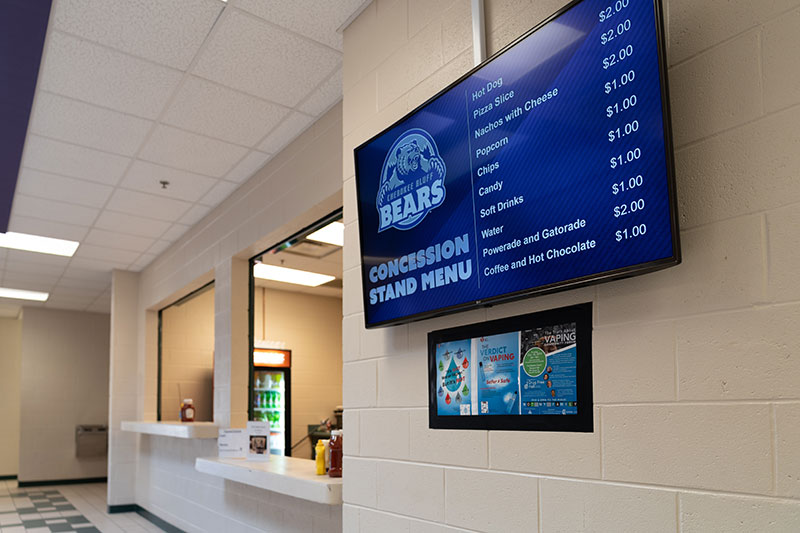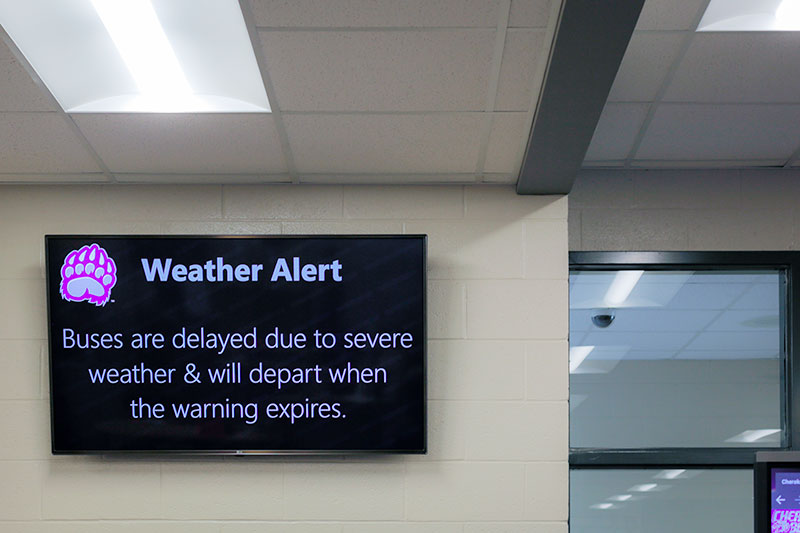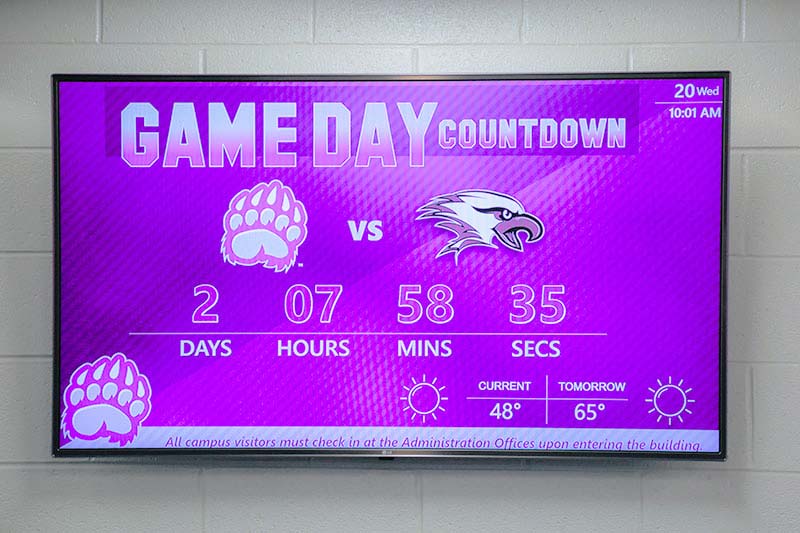The transition to a centralized Visix digital signage solution has helped the large Georgia school district achieve new heights in student achievement and district communications
Higher education institutions have embraced digital signage to a point where it resembles a catch-all medium. From wayfinding and interactive directories to student and faculty communications, digital signage is clearly the most effective way to disseminate meaningful information that covers all the bases.
K-12 districts have also found digital signage effective for a more focused set of needs. Specifically, schools have embraced digital signage as a centralized district-wide communications and safety tool to inform, educate and engage everyone roaming the halls. And as the technology continues to evolve and mature, users such as Hall County School District outside Atlanta are unlocking new ways to leverage the technology.
“Digital signage provides opportunities for school districts to move beyond simple information messaging,” said Dr. Aaron Turpin, assistant superintendent of technology, Hall County School District. “With our recent upgrade, we are making a push to have student achievement infiltrate the instructional environment.”
Based in Gainesville, Georgia, Hall County School District covers 10 adjacent communities with 20 elementary schools, seven middle schools and seven high schools, as well as two academies and an alternative learning center. The district has long been a proponent of digital signage, with several disparate systems used across various schools. The architecture required local school staff to manage multiple screens, often requiring support due to a lack of user-friendliness.
“Our challenges quickly escalated with the user and management experience, and keeping content fresh and relevant,” said Turpin. “The content uploading tasks at each school were putting a burden on local staff. There were also stability problems with some of the systems, and a lack of professional resolution in presentation with others. Essentially, there was nothing consistent about the operation, and the burden on our support resources grew.”
Turpin began having discussions with the team at Nisewonger AV, an Atlanta-area AV systems integration firm that has long specified and installed AV systems at Hall County School District. Beyond digital signage, the company is in the midst of installing new AV collaboration systems in select Hall County schools. These systems include collaborative workstations utilizing Solstice wireless collaboration systems, Cloud Electronics presentation systems with zoned audio control, Epson projection systems, and Cleartouch interactive panels.
Other manufacturers in the AV design including Tannoy (ceiling speakers), C2G (cabling and control), and LG Electronics (displays).
“I’ve been a superintendent for technology over my years as an educator, beginning as a teacher and then a principal at several schools,” said Turpin. “With digital signage specifically, what I really wanted was a singular system that would limit support constraints for my engineers. I also wanted to give our teachers a way to visually and accurately depict work samples that demonstrate student exemplars.”


Digital Transformation
Adam Yates has watched Nisewonger AV transform into a full-service systems integrator over the past five years. The timing couldn’t have been better given the enormous business opportunities in the commercial AV universe. Founder Jim Nisewonger and current President & CEO, Randy Nisewonger have spent their careers making Nisewonger AV a trusted name in the Georgia education market.
“We just celebrated our 50th year in business, and 2018 was our strongest year in a decade,” said Yates, a CTS-certified project sales engineer with the company. “Over the past five years, technology has changed and progressed at a rapid rate. The K-12 market is particularly exciting given that many are just beginning to move away from legacy systems that simply don’t perform as needed in today’s education environment.”
Digital signage has been a particularly lucrative segment for the company as schools seek more effective ways to communicate and market.
“School districts want to market themselves and showcase their student achievements, both in visual presentation and through social media feeds. They also want to provide information to parents, students and faculty, from general information to events happening in the district and around the county,” said Yates. “This is exactly what Hall County wanted to do, but they needed a more effective digital signage system to accomplish their goals.”
Nisewonger AV’s track record with Hall County dates to 2010, when the company began updating classroom with cabling, wallplates, displays and audio systems. With that trust established, Turpin looked to Yates to recommend a digital signage solution that would meet all his goals – and also offer an easy learning curve for his staff district-wide.
For Yates, the choice was clear: Transition the entire school to a Visix AxisTV digital signage software solution, spanning from the CMS through to the media players at each display.
Simple Integration
The AxisTV rollout began in mid-2018 across two phases, with “about 200” locations live for start of the 2018-2019 school year.
“They piloted some sites earlier in the year, and then we started to deploy the Visix network in three renovated schools over the summer: Cherokee Bluff Middle/High School, Flowery Branch High School, and Davis Middle School,” said Yates. “As we had modernized the cabling and infrastructure in all of these schools, we quickly installed displays in the front offices, front hallways, cafeterias and media centers, as well as other strategic areas within the school. We installed more than 30 professional, 55-inch LG displays in Cherokee Bluff alone. This gives you an idea of the expansive nature of the network once fully deployed.”
The Nisewonger team installed custom flat-tilt mounts from Crimson AV with each new landscape LG display. “They are fairly basic, but work very well on cinder block and drywall surfaces. They are extremely flexible and perfect for education environments.”
Existing LG displays were used in most of the remaining schools, mainly requiring that old players be swapped out for new Visix digital signage players. With network drops in place at most locations, integration labor was mainly limited to connecting Cat6 patch cables to the drops and HDMI cables to the display.
“Technically, most of these schools were running an IPTV system that carried their digital signage,” said Yates. “The network connection and power were already in place at the displays. The district provided us with static IP addresses, and we programmed all of the Visix players with IP addresses, domain names and other configurations to ensure network and player security. That provides added value for the district as they can more easily maintain and monitor the complete network.”
Yates emphasizes that he recommended Visix because it’s a true enterprise-level system, noting its benefits for network growth and user-friendliness.
“There are a number of digital signage systems out there that market themselves as enterprise-level, when in reality they fall short,” said Yates. “From an integrator’s perspective, the simple scalability of the AxisTV architecture make it easy to quickly add more screens without high costs or extensive labor. From the end user perspective, there are just a ton of options as to how you can use the system.”
For Hall County School District, this included extensive user-defined control. This provides a broad array of users with various levels of access to the network.
“A good example would be if a cafeteria manager wanted to publish menus on their digital boards,” said Yates. “They can set it up in a way that the cafeteria manager can only see his or her displays, and only post content to those displays. Someone in the front office may only be able to post a message to that local screen, whereas a school administrator may have access to the entire network. From a district IT level, this was very attractive to them.”

Operational Wins
Hall County School District is already finding new efficiencies in how they create, manage and deliver their digital signage content. They are also involving new organizations as a result, notably booster clubs and concession stands at sporting events.
“The most immediate benefit was that the learning curve was very quick,” said Turpin. “Principals can assign management tasks to virtually anyone in the district. They don’t need to be media specialists or have technical engineering degrees to operate the system. We have grade-level teachers posting their own content. That has been especially helpful in accomplishing our goal of publishing student achievement on a regular basis. We are publishing authentic student work on these screens.”
Turpin adds that the district has been leveraging social media more than ever, which he says helps his goal of keeping content fresh and relevant. He also notes that Visix has fostered an environment of effective communication district-wide, with timely and useful information posted on a regular basis.
The transition to AxisTV has also solved the reliability and stability problems of his previous systems. “It has worked every minute of every day,” he said. “We don’t have to deal with the headache of resets anymore, and unplugging and re-plugging boxes.”
For Turpin, it really comes back to demonstrating student exemplars – and taking the satisfaction of that with them when they leave school for the day.
“We expect our kids to take the knowledge that they are gaining, and produce new heights of knowledge with it,” he said. “That often comes in some sort of class project, often-time digital. That means we can publish authentic evidence of learning on a daily basis. That simply was not possible before deploying Visix.”